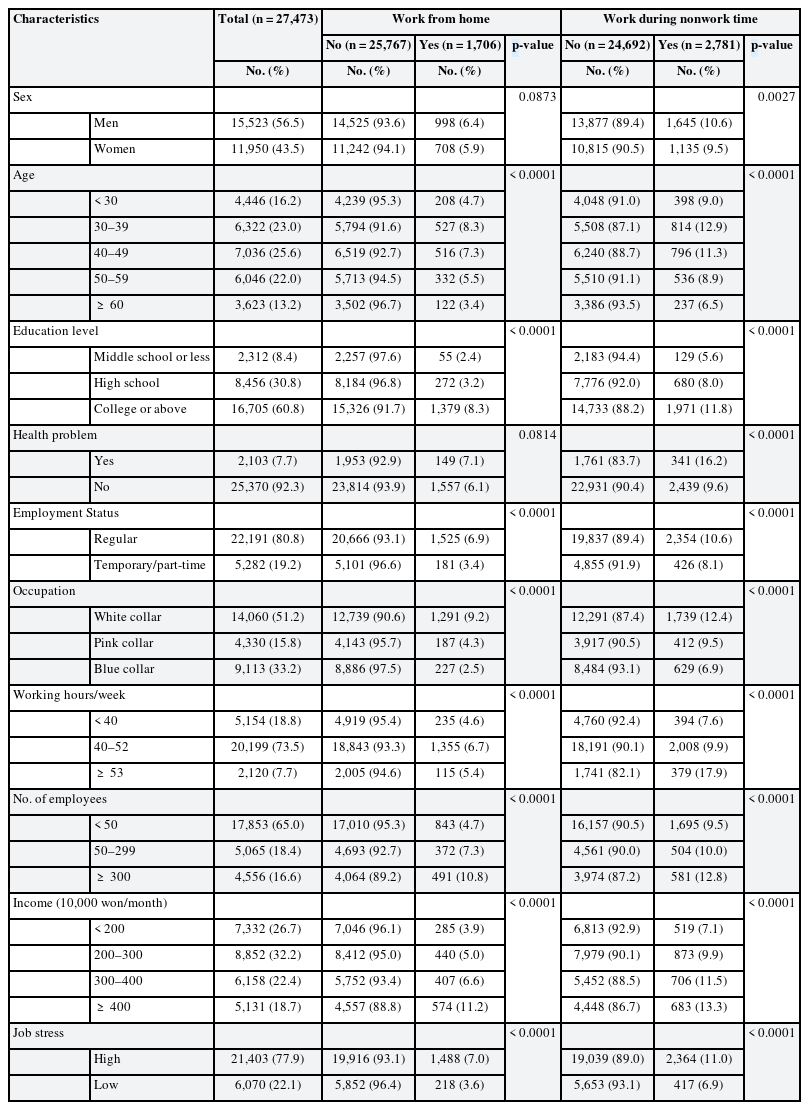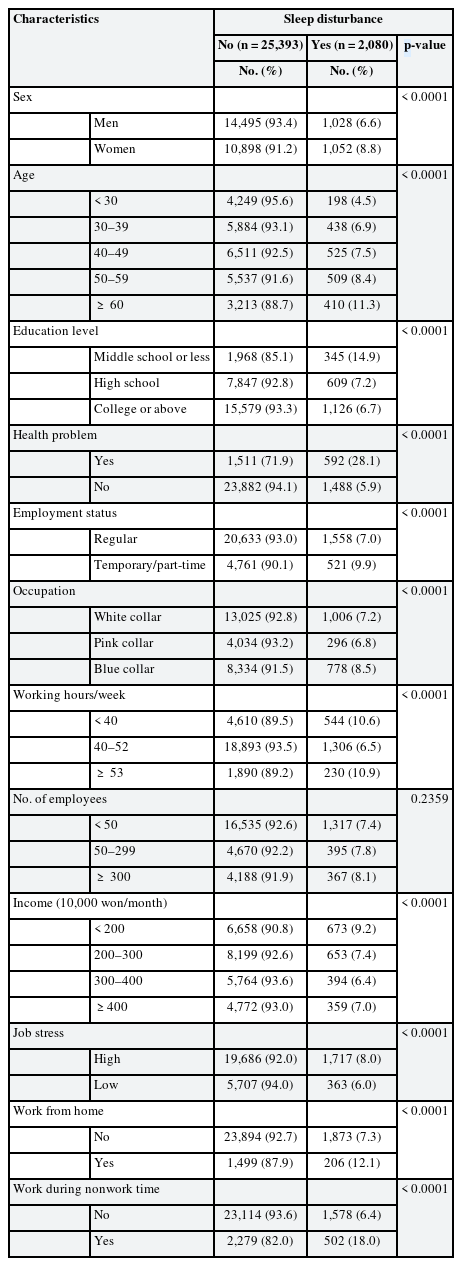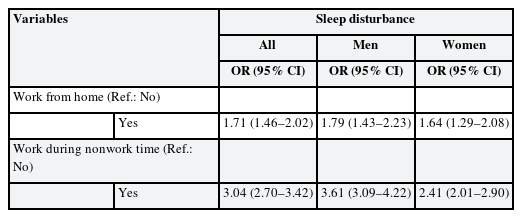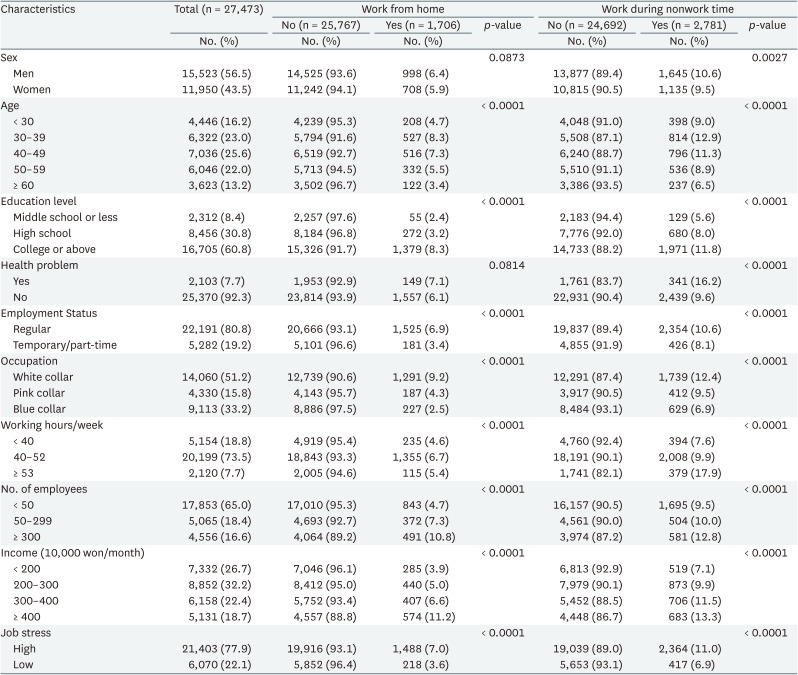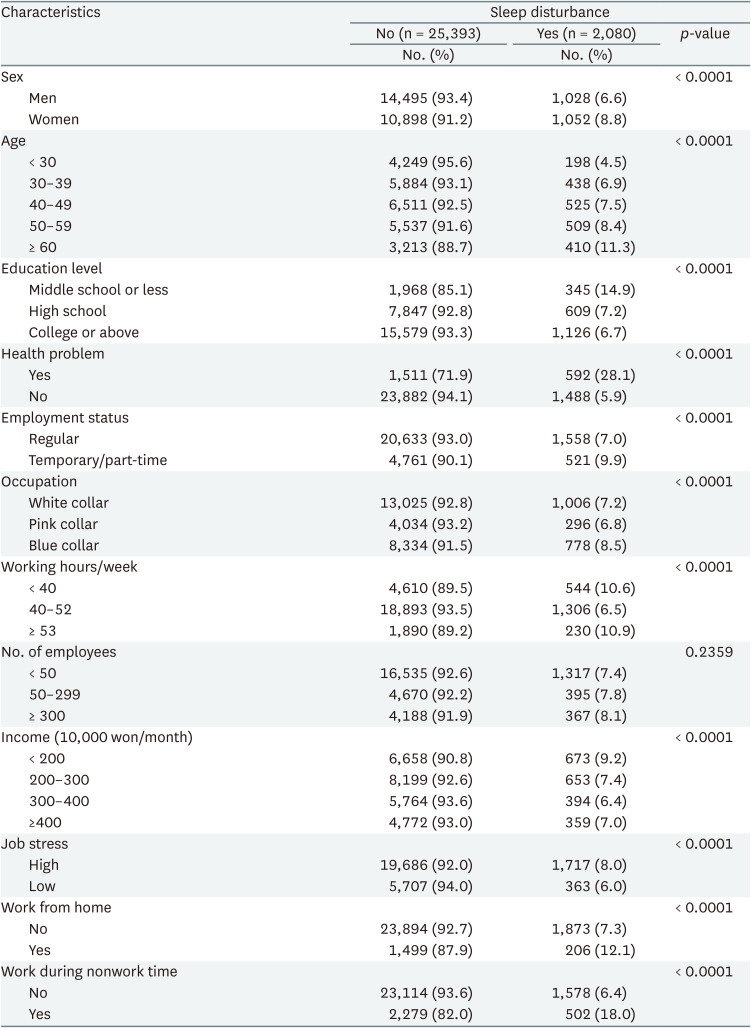Combined effect of work from home and work during nonwork time on sleep disturbance
Article information
Abstract
Background
Owing to the coronavirus disease 2019 pandemic, being exposed to work from home and work during nonwork time simultaneously can lead to sleep disturbance; however, their combined effect is unclear. We aimed to investigate the combined effect of work from home and work during nonwork time on sleep disturbance.
Methods
This study used data from the Sixth Korean Working Condition Survey and included 27,473 paid workers. Logistic regression analysis was conducted to investigate the relationship between work from home, work during nonwork time, and sleep disturbance according to sex. We re-classified participants into 4 groups based on their working from home (No/Yes) and working during nonwork time (No/Yes). The relative excess risk due to interaction was calculated to examine the effect of exposure to both telecommuting and non-regular work hours on sleep disturbance.
Results
Workers exposed to work from home and work during nonwork time had significantly higher risks of sleep disturbance for all, men, and women workers (OR [95% CI]: 1.71 [1.46–2.02], 1.79 [1.43–2.23], and 1.64 [1.29–2.08] for work from home and 3.04 [2.70–3.42], 3.61 [3.09–4.22], and 2.41 [2.01–2.90] for work during nonwork time, respectively). Compared to those who were not exposed to both factors, when workers had both job factors, the ORs (95% CI) of sleep disturbance for all, men, and women were 3.93 (2.80–5.53), 5.08 (3.21–8.03), and 2.91 (1.74–4.87), respectively. The relative excess risk due to interaction of work from home and work during nonwork time was not significant for sleep disturbance.
Conclusions
Work from home and work during nonwork time were each associated with sleep disturbance, but the interaction between the two factors on sleep disturbance was not observed in both men and women.
BACKGROUND
The coronavirus disease 2019 (COVID-19) pandemic, which began in early 2020, has deeply affected daily life. Social distancing was implemented by governments to prevent the spread of this infectious disease, and telecommuting was recommended to reduce human-to-human contact in the working environment. In the United States and Europe, where strong closure measures were implemented, 50% and 37% of all employed people worked from home,12 respectively, and telecommuting was activated in a short period of time in Korea. The number of telecommuters in 2019 was approximately 9.5 million, which accounted for 0.5% of the total number of employees; however, it was approximately 1.14 million (5.4% of the total employed) in 2021 during the COVID-19 pandemic, indicating an increase by more than 10 times.34
Several studies have investigated the effects of telecommuting on workers. The positive effects were improvements in work flexibility and autonomy, and an improvement in productivity because of shortening of commuting time and working during that period instead.56 Conversely, some studies have shown that working was difficult because of worsening presentism, lack of support from colleagues, and lack of equipment.78 Telecommuting weakens the boundaries of time and space, which traditionally distinguished work from nonwork hours.9 These boundaries can make it difficult for workers to escape from work anytime, anywhere, and work outside of work hours.10 This is called extended availability for work11 or unregulated availability,12 which erases the distinction between work and free time, making it possible to work continuously.13 Consequently, workers' ability to recover from work decreases,14 leading to role overload, anxiety, job satisfaction, and decreased performance.15 Working from home could affect circadian rhythms. Changes in sleep/wake patterns and reduced exposure to light could disrupt circadian rhythms, mainly due to lack of sleep and increased sedentary lifestyle.16 Work during nonwork time is associated with sleep disturbance owing to an increase in the total number of working hours,17 long hours of screen time, sedentarism and blurring boundaries of work and nonwork.18
Sleep plays an important role in physiological and psychological functions and quality of life.19 Inadequate sleep is associated with cardiovascular disease, obesity,20 and an increase in depression.21 Sleep disturbance reduces productivity and increase accident risk, absenteeism, and turnover in workers.22 As such, workers' sleep disturbance is a particularly important factor in health as well as accident prevention.
Prevention of sleep disturbance in workers is an important issue; therefore, work from home and work during nonwork time should be considered important factors. Although some studies have shown that workers who work from home have longer sleep durations than workers who do not,23 another study found that sleep durations are shorter in those who telecommute.24 However, studies on the combined effect of the two factors are scarce. Therefore, the effects of work from home and work during nonwork time on sleep disturbance and the combined effect of the two were investigated according to sex.
METHODS
Study population
A total of 50,538 wage workers who participated in the 6th Korean Working Conditions Survey (KWCS) in 2020 were screened for inclusion. Self-employed workers, unpaid family workers, and soldiers were excluded. Additionally, shift workers were excluded to remove any effect that shift working may have had on sleep disturbance. Participants with missing variable data (did not respond) and those who responded as “other,” “don’t know/no answer,” and “reject” were also excluded. Finally, 23,908 people were selected for this study.
Main variables
Work from home
Regarding the question, “During the last 12 months (or since you have started your job), how often have you worked in any of the following locations?”, for the option of “your own home,” those who answered “always,” “most of the time,” “sometimes,” and “rarely” were classified under “work from home.” Those who responded as “never” were classified under “no work from home.”
Work during nonwork time
Work during nonwork time was assessed using the question, “Over the last 12 months (or since you started your job), how often have you worked in your free time to meet work demands?” Those who answered “daily,” “several times a week,” and “several times a month” were classified under “work during nonwork time.” Those who answered “less often” or “never” were classified under “no work during nonwork time.”
Sleep disturbance
Sleep disturbance was assessed using the Minimal Insomnia Symptom Scale (MISS).25 The question, “Over the last 12 months (or since you started your job), how often did you have any of the following sleep-related problems?” was asked to measure sleep disturbance. The three problems included “difficulty falling asleep,” “waking up repeatedly during sleep,” and “waking up feeling exhausted and fatigued.” These responses were assigned 0–5 points in each response: “daily” (4 points), “several times a week” (3 points), “several times a month” (2 points), “less often” (1 point), and “never” (0 point). By summing the scores, a score of 6 or more was classified as having sleep disturbance, and a score of 5 or less was classified as no sleep disturbance.
Covariates
General characteristics included sex, age (< 30, 30–39, 40–49, 50–59, and ≥ 60 years), education level (middle school or less, high school graduate, and college or above), and health problems. Health problems were assessed using the question: “Do you have an illness or health problem which has lasted, or is expected to last, for more than 6 months?” with two response options: yes and no.
Occupational characteristics included occupation, employment status, weekly working hours, size of workplace, income, and job stress. Occupations were classified based on nine occupations from the Korean Standard Classification of Occupations. Managers, experts and related workers, and office workers were classified as white collar; service workers and sales workers, pink collar; and, skilled workers in agriculture and fisheries, technicians, equipment/machine operators, and assembly workers and simple laborers, blue collar. Employment status was grouped into regular and temporary/part-time. Weekly working hours were classified as ≤ 40, 41–52, and ≥ 53 hours. Number of employees was divided into < 50, 50–299, and ≥ 300. Income was grouped into 10,000 Korean won/month units and was classified as < 200, 200–300, 300–399, and ≥ 400. Job stress was estimated using the question: “Do you experience stress in your work?” The participants who responded “always,” “most of the time,” and “sometimes” were classified as “high” and “rarely,” respectively; “never” was classified as “low.”
Statistical analysis
The final data analysis was performed by applying the weights presented in the dataset under the KWCS data usage manual. The χ2 test was used to assess the distribution of sleep disturbance according to the worker’s general and occupational characteristics.
Multivariable logistic regression analysis was used to obtain the odds ratios (ORs) and 95% confidence intervals (CIs) to investigate the relationship between work from home or work during nonwork time and sleep disturbance. We performed a sex-stratified analysis because there may be sex differences in the effects of work from home or work during nonwork time on the risk of sleep disturbance.
Work from home can be perceived to lead to work during nonwork time as this practice erases the boundary between work and free time. However, the result of Pearson correlation analysis showed a correlation coefficient of 0.09, indicating a low correlation between the two.
Finally, to assess the combined effect of the 2 exposure factors, the 2 variables were grouped and re-classified into 4 groups: “work from home (no)–work during nonwork time (no),” “work from home (yes)–work during nonwork time (no),” “work from home (no)–work during nonwork time (yes),” and “work from home (yes)–work during nonwork time (yes).” Multivariable logistic regression was used to estimate the ORs and 95% CIs. For identifying the potential additive effect of work from home and work during nonwork time, the relative excess risk due to interaction (RERI) and statistical significance were estimated.26 RERI is used to investigate the presence of a synergistic effect of the two exposures. Synergistic interaction is suggested in case of RERI greater than 0.27
The p-values less than 0.05 were regarded as statistically significant. All statistical analyses were performed using the SAS software version 9.4 (SAS Institute Inc., Cary, NC, USA).
Ethics statement
This study was approved by the Institutional Review Board (IRB) of Ajou University Hospital (IRB No. 2022-0911-001).
RESULTS
The general characteristics of the study participants are presented in Table 1. After weighing, 27,473 participants were included in the study, with 15,523 (56.5%) men and 11,950 (43.5%) women. The percentage of workers who worked from home was the highest among those in their 30s. The rate of telecommuting was higher in the group with collegiate education or above, full-time workers, white collar workers, those working 40–52 hours per week, in workplace sizes of 250 or more, those with a monthly income of ≥ 4 million won, and those with high job stress. General and occupational distribution of work during nonwork time was the same as the tendency of telecommuting, except that the proportion of workers who worked during nonwork time was the highest in the ≥ 53 working hours group.
The distribution of sleep disturbance according to general characteristics, work-from-home, and work-during-nonwork time is presented in Table 2. The sleep disturbance was significantly higher in the higher the age, the lower the educational level, the group with health problems, non-regular workers, the group with high job stress, and the group that work-from-home or work-during-nonwork-time (p < 0.0001).
Logistic regression analysis results for work from home, work during nonwork time, and sleep disturbance are presented in Table 3. When compared with the non-telecommuting group, the OR of sleep disturbance in the telecommuting group were 1.71 (95% CI: 1.46–2.02) in both sexes. For men workers, the OR of sleep disturbance was 1.79 (95% CI: 1.43–2.23), and 1.64 (95% CI: 1.29–2.08) for women workers. When compared with the work-during-nonwork-time group, the ORs of sleep disturbance in the work-during-nonwork-time group were 3.04 (95% CI: 2.70–3.42) in both sexes. For men workers, the OR of sleep disturbance was 3.61 (95% CI: 3.09–4.22), and 2.41 (95% CI: 2.01–2.90) for women workers.
The analysis of the four reclassified groups (each with a unique variation of the two combined exposure factors) that examined the combined effects of work from home and work during nonwork time is presented in Table 4. Compared with the reference group, the concurrently exposed group showed a high increase in the OR, i.e., 3.93 times (95% CI: 2.80–5.53) in both sexes, 5.08 times (95% CI: 3.21–8.03) in men workers and 2.91 times (95% CI: 1.74–4.87) in women workers compared to the group that was exposed to only one risk factor.
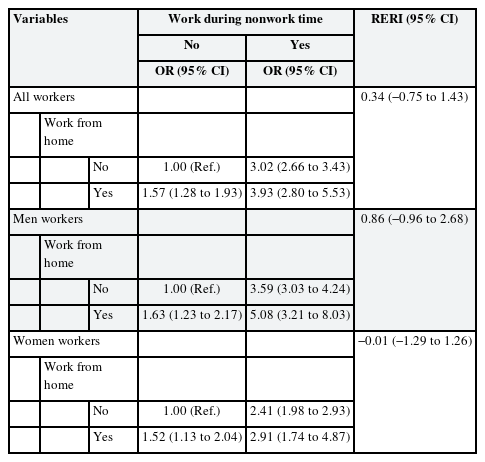
Combined effect of work from home and work during nonwork time on sleep disturbance stratified by sex
The RERI for both sexes was 0.34 (95% CI: −0.75, 1.43), 0.86 (95% CI: −0.96, 2.68) for male, and −0.01 (95% CI: −1.29, 1.26) for female. The RERI results provided evidence of a positive additive interaction between work from home and work during nonwork time in male workers but it was not statistically significant.
DISCUSSION
This study investigated the relationship between telecommuting and work during nonwork time and its influence on sleep disturbance among domestic wage workers using data from the 6th KWCS. White collar, better educated, higher paid, and larger staffed workplace workers showed higher rates of telecommuting, corroborating previous findings.28 Among work-from-home and work-during-nonwork-time workers, the risks of sleep disturbance measurement were high in both male and female. Even though we could not identify the synergistic effect of 2 factors, men’s sleep disturbance was much greater than women’s when work from home and work during nonwork time simultaneously exposed.
There are several possible explanations for the findings regarding the association between work from home and sleep disturbance. The first is an increase in work-family interference. Working from home blurs the boundaries between work and home and increases work-family interference because workers attempt to manage multiple things simultaneously.29 An increase in work-family interference is associated with sleep disturbance.30 The work–home interference in the group who worked from home was approximately twice that of the group that did not work from home (Supplementary Table 1). Lack of separation between the individual and family of workers increases night working hours and stress, which can lead to sleep cycle dysregulation and impaired sleep quality.31
The second is the effect of social isolation. Telecommuting results in a lack of social interaction and can lead to emotional isolation and increased stress because of physical disconnection and the lack of social support from colleagues.32 Loneliness is an unpleasant feeling that arises when a sense of belonging is not felt,33 and it can interfere with efficient sleep, reduce sleep quality and sleep duration, and worsen daytime sleepiness.34 Social isolation owing to telecommuting can be associated with worsened sleep quality.35
In addition, working from home can increase working hours,36 which appears to be a combined effect related to both the employers and the workers who telecommute. Employers expect teleworkers to use their free time, and this expectation alone can increase workers’ sleep disturbances.37 Workers tend to work longer than the set working hours to compensate for their absence in the organization while working from home.38 Telecommuters deem themselves at a disadvantage in the performance review and development process; therefore, they spend more time working,39 and working in addition to regular working hours increases the total working hours.1840 According to several studies, increase in working hours has an effect on sleep disturbance.17
Alternatively, several studies have shown that telecommuting has a positive effect on sleep. Owing to the ability to wake up late, sleep duration can be prolonged. Sleep disturbance tend to decline in people with late chronotype.2341 As sleep pattern, bedtime, wake-up time, and individual chronotype data were not available for this study, their potentially positive effects on telecommuting could not be identified.
Regarding the study results on work during nonwork time and sleep disturbance, psychological separation from work during off-hours is associated with workers’ well-being,42 and psychological separation from work during leisure time is more likely to be associated with sleep quality rather than continuous thinking about work-related issues. Psychological separation is deemed beneficial and less tiring.43 However, it is difficult to completely free oneself from work if work orders are received via email or phone, particularly during nonworking hours. Working after working hours is a job demand that causes emotional exhaustion and fatigue and can cause sleep disturbance.4445 Analysis of the participant data from this study revealed that, during free time, work–family interference was approximately 5 times higher in the working group than that in the nonworking group (Supplementary Table 2). Work–family conflict can lead to sleep disturbance and impaired sleep quality.31
A synergy effect was not seen in this study on sleep disturbance of concurrent exposure of work from home and work during nonwork time. Nevertheless, when exposed to both factors simultaneously, men’s sleep disturbance was greater than women’s. In previous studies, the health outcomes of telecommuting could be worsen in women, but the gender effects are controversial.4647 Since this study was conducted at a time when people were forced to work form home due to pandemic, direct comparison with research before COVID-19 would be difficult. This is because the spontaneity of telecommuting could affect outcomes.48 In Korean society, women traditionally have higher demands on household chores than men. However, while being forced to work from home under COVID-19, the responsibility of taking care of the family has increased due to closure of children’s school or care facilities of elderly.49 When working from home, fathers may experience increased stress and pain, decreased happiness while mothers may experience increased happiness.46 Also, male telecommuters may experience higher work-family conflict than females when work-family integration was requested.50 In this study, we could not identify how long men and women work during nonwork time, but men prioritized their work, considered paid work as their main area, and identify with themselves,51 so it could be expected that men would spend more energy on work during nonwork time than women. As the overall prevalence of sleep disturbance was higher in women, a greater impact of telecommuting could be observed in men. In this study, we could identify the difference in the prevalence of sleep disturbance by sex whether they work from home or work during nonwork time. (Supplementary Tables 3 and 4).
An important finding in this study is that telecommuting itself could affect sleep disturbance. Previous studies have shown that working form home could increase working hours and affect sleep disturbance.18 However, by separating the effects of telecommuting and overtime work on sleep disturbance, this study showed that sleep disturbance is related to work from home alone, not as a result of increased working hours.
This study has several limitations. First, a causal relationship could not be demonstrated because the KWCS (the data source) is a cross-sectional study. Second, the variables were limited to the existing questionnaire items. We could not determine the duration or the spontaneity of telecommuting, and we could not identify lifestyle habits such as drinking, smoking, caffeine intake, body mass index, and past history that could affect sleep disturbance. However, steps were taken to minimize the potential impact on overall health by adjusting for health problems. Third, as the KWCS is a self-report questionnaire, data are subjective by nature, and the clinical diagnosis of sleep disturbance was not available. However, the question regarding sleep disturbance is commonly used as a brief measure of sleeping difficulties.25
This study is impactful in that it used the 6th and most recent KWCS that represented Korean workers. In addition, no previous studies explored the combined effect of telecommuting and work during nonwork time on sleep disturbance with such a large sample population as that of the KWCS.
CONCLUSIONS
This study suggests that work from home and work during nonwork time are each associated with sleep disturbance, and the effect could be greater in men. As telecommuting has become a new standard for work, it is necessary to protect workers who telecommute. Additionally, there is a need for a system or policy to prevent workers from working overtime.
Notes
Competing interests: Inchul Jeong has been a member of the editorial board of the Annals of Occupational and Environmental Medicine since 2020. He was not involved in the review process. Otherwise, no potential conflict of interest relevant to this article was reported.
Author Contributions:
Conceptualization: Lim J, Lee H, Jung J.
Data curation: Lim J, Lee H.
Formal analysis: Lim J, Jeong I.
Investigation: Lim J, Jung J.
Methodology: Jung J.
Supervision: Park JB, Lee KJ, Jeong I, Jung J.
Abbreviations
CI
95% confidence interval
COVID-19
coronavirus disease 2019
KWCS
Korean Working Conditions Survey
MISS
Minimal Insomnia Symptom Scale
OR
odds ratio
RERI
relative excess risk due to interaction
References
SUPPLEMENTARY MATERIALS
Supplementary Table 1
Adjusted OR for work-family interference by work from home
Supplementary Table 2
Adjusted OR for work-family interference by work during nonwork time
Supplementary Table 3
Prevalence of sleep disturbance by work from home and work during nonwork time stratified by sex
Supplementary Table 4
Combined prevalence of sleep disturbance by work from home and work during nonwork time stratified by sex

